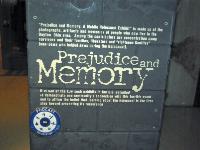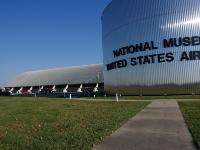 1 The Early Years gallery takes you from the beginnings of flight to the eve of WWII. The sign at the entrance explains why the museum asks us not to touch the exhibits: "We hope your grandchildren and their grandchildren will some day visit the USAF Museum. We hope the aircraft and artifacts will be here for them to see, study and enjoy in the future in just as fine condition as they are today." |
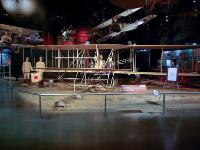 2 The Wright 1909 Military Flyer became the first military heavier-than-air flying machine. The army named it Signal Corps No. 1 and the original is now on exhibit at the National Air and Space Museum, Washington, D.C. This airplane on display is an exacting reproduction constructed by museum personnel in 1955. It is equipped with an engine donated by Orville Wright and chains, sprockets and propellers donated by the heirs of the Wright estate. |
 3 In 1911 the U.S. Army Signal Corps purchased its second airplane, a Curtiss Model D Type IV. The control system operated differently than that used on Signal Corps No. 1. A pilot flying the Curtiss operated the ailerons with his shoulders, and the front elevator and rear rudder with the wheel mounted on a column in front of him. Museum personnel constructed the reproduction on display, completing it in 1987. Except for the engine, which is made of wood and plastic, all materials used in the reproduction are essentially the same as those used in the original. |
 4 This is a replica of the wind tunnel designed and built by the Wright Brothers in the fall of 1901 to test airfoil designs. The blower fan, driven by an overhead belt, produced a 25 to 35 mph wind for testing the lift of various planes and curved surfaces. Aerodynamic tables derived from these tests were vital to the successful design of the Wright 1903 Kitty Hawk airplane. |
 5 Inside the tunnel is a model of a Wright lift balance used to measure the lift of a test surface. The wind tunnel replica was constructed under the personal supervision of Orville Wright prior to World War II. |
 6 This picture of the take-off of the 1903 Wright Flyer at Kittyhawk, North Carolina is the same picture used in the huge mosaic in Carney Auditorium area (See "Miscellaneous" Folder) |
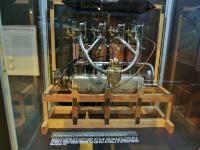 7 America's first military aircraft engine: a Curtiss four-cylinder, water-cooled engine used in the 1908 Signal Corps Dirigible No. 1. Developing about 25 hp, it drove a tubular steel shaft 22 feet long on which was mounted a wooden propeller. In the official speed trial, the airship reached 19.61 mph. The engine is on loan from the National Air & Space Museum, Washington, D.C. |
 8 The BLERIOT MONOPLANE was an important early aircraft because of its inventor's notable exploits and the aircraft's role in early training and reconnaissance. It first achieved fame in 1909 when its designer, Louis Bleriot of France, piloted one on the first flight across the English Channel. Mr. Ernest Hall of Warren, Ohio, built the Bleriot on display in 1911 from factory drawings and with it taught himself to fly. Mr. Hall donated the aircraft to the museum in 1969. |
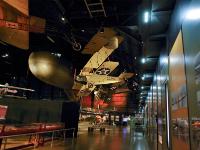 9 The STANDARD AIRCRAFT CO J-1 hanging from the ceiling was a two-seat primary trainer used by the U.S. Army Air Service to supplement the JN-4 Jenny. |
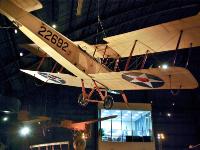 10 Though similar in appearance to the JN-4, the J-1 was more difficult to fly and never gained the popularity of the legendary Jenny. |
 11 After America entered World War I, it took many months to build the training facilities needed by the U.S. Army Air Service. Those sent to Great Britain for training learned on the Avro 504K trainer before advancing to combat aircraft. The U.S. Army Air Service eventually established its main training center at Issoudun, France, and in July 1918, the American Expeditionary Force (AEF) commanders ordered 52 Avro 504K aircraft for teaching aerobatics at Issoudun. |
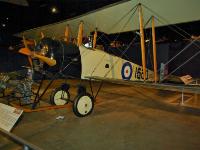 12 Using original parts, the Royal Canadian Air Force's Aircraft Maintenance & Development Unit built the aircraft on display in 1966-1967 with a 110-hp Le Rhone J rotary engine. It arrived at the museum in May 2003 and it is painted to represent one of the 52 Avro 504K aerobatic trainers used at the AEF No. 3 Instruction Center, Issoudun, France, in 1918. |
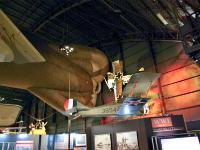 13 The CURTIS JN-4D "JENNY" became America's most famous World War I training airplane. Generally used for primary flight training, some Jennies were equipped with machine guns and bomb racks for advanced training. After WWI, the Army sold hundreds of surplus JN-4s to civilians. The airplane soon became the mainstay of the "barnstormers" of the 1920s, and many Jennies continued flying into the 1930s. |
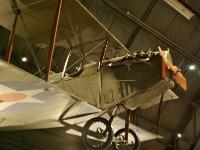 14 EBERHART SE-5E. When the U.S. entered WW I, plans called for American manufacturers to mass produce aircraft already in use by the Allies. One of the fighters chosen was the British S.E.5A and the U.S. government placed orders with Curtiss. The Armistice halted production after Curtiss had completed only one S.E.5A but 56 more were constructed from components shipped from Great Britain. In 1922 the Eberhart Steel Products Co. received a contract to rebuild 50 of the Army Air Service's S.E.5A aircraft using 180-hp Wright-Hispano "E" engines. |
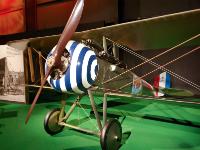 15 The French-built NIEUPORT 28 became the first fighter airplane flown in combat by pilots of the American Expeditionary Force (AEF) in World War I. The lightly built Nieuport 28 developed a reputation for shedding its upper wing fabric in a dive. |
 16 This reproduction was rebuilt by museum personnel. It contains wood and hardware from an original Nieuport 28. The aircraft is painted and marked to represent a Nieuport of the 95th Aero Squadron, Third Flight, as it appeared in July 1918. It was placed on display in May 1994. |
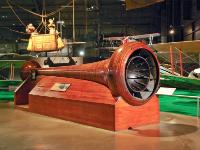 17 This wind tunnel was designed and built at McCook Field, Ohio, in 1918. Using a 24-blade fan of 60 inches diameter, the tunnel developed a maximum air speed of 453 mph at its 14-inch diameter choke-throat test area. It was used for calibrating airspeed instruments and testing airfoils. |
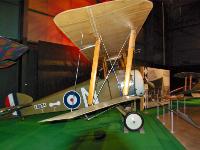 18 The British SOPWITH CAMEL F-1 shot down more enemy aircraft than any other World War I fighter. It was highly maneuverable and very difficult to defeat in a dogfight. However, because of its tricky handling characteristics more men lost their lives while learning to fly it than died while using it in combat. |
 19 The Camel first went into action in June 1917 with 70 Squadron Royal Flying Corps, and 4 Squadron Royal Naval Air Service. Two U.S. Army Air Service squadrons, the 17th and 148th, flew the Camel in combat while assigned to British forces during the summer and autumn of 1918. |
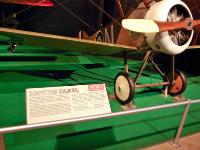 20 Although 5,490 Camels were produced, very few remain in existence today. USAF personnel built the Camel on display from the original WWI factory drawings, completing it in 1974. The aircraft is painted and marked as the Camel flown by Lt. George A. Vaughn Jr., 17th Aero Squadron. |
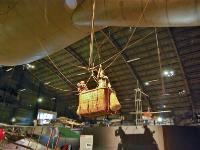 21 Tethered balloons allowed World War I observers to see as far as 40 miles behind enemy lines to spot troop movements, chart trench systems and direct artillery fire. The observation balloon most used by Americans was named for its designer, French engineer Lt. Albert Caquot. The hydrogen-filled balloon could lift two passengers in its basket, along with charting and communications equipment, plus the weight of its mooring cable, to a height of about 4,000 feet in good weather. |
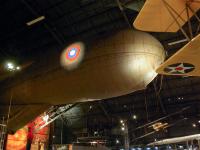 22 Caquot balloons were manufactured in great numbers in WWI; nearly 1,000 were made in the United States in 1918-1919. During World War II, the British produced Caquots once again, but in limited numbers. The balloon displayed at the museum was manufactured in 1944 and is believed to be the only survivor. Assisted by the Goodyear Aerospace Corp. of Akron Ohio, museum personnel mended and sealed the balloon fabric and prepared it for inflation. It was placed on display in May 1979 |
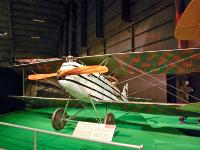 23 Introduced into combat during the last great German offensive of World War I, the HALBERSTADT CL IV supported German troops by attacking Allied ground positions. It was equipped with both fixed and flexible machine guns, hand-dropped grenades and small bombs but it lacked the armor necessary for protection against ground fire. |
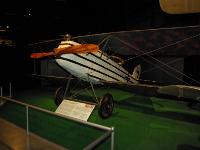 24 The museum acquired the Halberstadt CL IV on display in 1984. Badly deteriorated at the time, its restoration was a joint international cooperative venture by the Museum fur Verkehr und Technik in Berlin Germany, the Smithsonian Institution's National Air and Space Museum and the National Museum of the United States Air Force. |
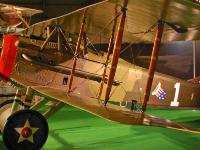 25 SPAD XIII C-1. In 1916 a new generation of German fighters threatened to win air superiority over the Western Front. The French aircraft company, Société pour l'Aviation et ses Dérives (SPAD), responded by developing a replacement for its highly successful SPAD VII. Essentially a larger version of the SPAD VII with a more powerful V-8 Hispano-Suiza engine, the prototype SPAD XIII C.1 first flew in March 1917. |
 26 With its 220-hp engine, the SPAD XIII reached a top speed of 135 mph -- about 10 mph faster than the new German fighters. It carried two .303-cal. Vickers machine guns mounted above the engine. Each gun had 400 rounds of ammunition, and the pilot could fire the guns separately or together. Technical problems hampered production until late 1917, but nine different companies built a total of 8,472 SPAD XIIIs by the time production ceased in 1919. |
 27 Since the United States entered World War I without a combat-ready fighter of its own, the U.S. Army Air Service obtained fighters built by the Allies. By the war's end, the Air Service had accepted 893 SPAD XIIIs from the French, and these aircraft equipped 15 of the 16 American fighter squadrons. |
 28 The FOKKER D-VII first appeared in combat in May 1918. With its high rate of climb, higher ceiling and excellent handling characteristics, German pilots scored a remarkable 565 victories over Allied aircraft during the month of August alone. |
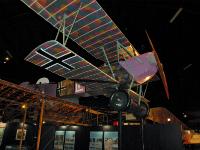 29 The reproduction aircraft on display is painted to represent the Fokker D. VII of Lt. Rudolph Stark, a squadron leader of Jasta (Fighter Squadron) 35b in October 1918. It was placed on exhibit in May 1996. |
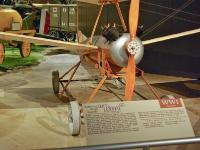 30 In 1917 Charles Kettering of Dayton, Ohio, invented the unmanned aerial torpedo, nicknamed the "Bug". The man is more interesting than the invention. He was a researcher for National Cash Register (later NCR) and was a founder of Delco (Dayton Engineering Laboratories). He became head of research for General Motors for 27 years and among his most widely used automotive inventions were the electrical starting motor and leaded gasoline. Monuments to his name cover Dayton and, in 1970 I spent nearly 12 months in a Dayton suburb called Kettering. |
 31 The U.S. Army Air Service used the STANDARD J-1 during World War I for primary flight instruction. Although 1,601 J-1s were produced, the J-1 never achieved the popularity of the more numerous JN-4 Jenny. The fabric covering on the fuselage has been removed to illustrate the wire-braced wooden construction typical for aircraft of that time. It also reveals the dual controls and relatively simple cockpit instrumentation. The black tank in front of the forward cockpit is the fuel tank. This airplane was donated to the Air Force Museum Foundation in December 1962 . |
 32 The DE HAVILLAND DH-4 was used by the U.S. Army Air Service both during and following World War I. When the United States entered WWI in April 1917 it had only 132 aircraft, all obsolete. Modeled from a combat tested British De Havilland design, the DH-4 was the only U.S. built aircraft to see combat during WWI. With inadequate funding to buy new aircraft, the newly created U.S. Army Air Service continued to use the DH-4 in a number of roles during the lean years following the war. By the time it was finally retired from service in 1932, the DH-4 had been developed into over 60 variants. |
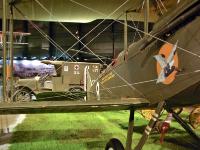 33 Of the three U.S. companies that built the DH-4 during WWI, the largest producer was the Dayton-Wright Co. of Dayton, Ohio. The Air Service ordered over 12,000 DH-4s, but a number of problems kept initial production figures low and construction quality was poor. The many changes involved in converting the design to American production standards, along with the use of the American Liberty 12-cylinder engine rather than the Rolls Royce engine of the British model, contributed to early production delays. |
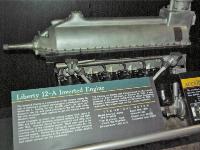 34 The inverted LIBERTY 12-A is a conversion of the famous Liberty 12, one of America's greatest technological contributions during World War I. During the war, 20,478 Liberty 12s were produced in the United States and used primarily in U.S.-built DH-4s, the only American-made airplane to get into combat over the Western Front. The Liberty on display was manufactured by the Lincoln Motor Co., Detroit, Mich., on Oct. 18, 1918. |
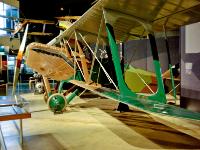 35 The PACKARD LEPERE LUSAC 11 was designed in 1917 by Georges LePere, a French aeronautical engineer working for the U.S. Army Air Service. The LUSAC 11 was the result of efforts to get an American built fighter into combat as soon as possible and it was a combination fighter, light bomber and reconnaissance aircraft that carried a pilot and an observer/gunner. The aircraft on display is the only LUSAC 11 in existence. In 1989 the museum acquired it from the Musee de l'Air in Paris, France and, after restoration by museum personnel, it went on display in 1992. |
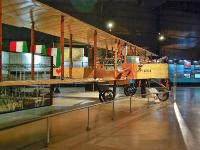 36 CAPRONI CA. 36. During World War I, Italian aeronautical engineer Gianni Caproni developed a series of multi-engine heavy bombers that played a key role in the Allied strategic bombing campaign. His bombers were produced not only in Italy, but also in France, Great Britain and the United States. |
 37 FORD MODEL T AMBULANCE. During World War I, the Allies used thousands of Model T cars and trucks because of their low cost and ease of repair. The ambulance version's light weight made it well-suited for use on the muddy and shell-torn roads in forward combat areas. By Nov. 1, 1918, 4,362 Model T ambulances had been shipped overseas. |
 38 The 225-hp WRIGHT R-790 was a standard U.S. Air Corps radial engine used in several types of airplanes during the 1920s and 1930s. The engine on display is one of three Wright R-790s that powered the Fokker trimotor during its non-stop flight from the United States to Hawaii in 1927. The civilian version of the R-790, the Wright J-5 Whirlwind, powered Mr. Charles A. Lindbergh's Spirit of St. Louis during his historic 1927 New York-to-Paris flight. |
 39 CURTIS P-6E "HAWK" Starting in 1925 with the P-1, Curtiss built a long series of fighters carrying the name "Hawk." Curtiss delivered 46 P-6E Hawks, the last biplane fighter built in quantity for the Air Corps. Never used in combat, the P-6E is recognized as one of the most beautiful aircraft of the 1930s. |
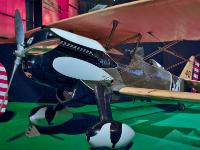 40 This is the only original P-6E still in existence. Edward Perkins of Anniston, Alabama donated it to the museum and, in 1963, the Department of Aviation Technology at Purdue University restored it. |
 41 The BOEING P-12E was developed by the Boeing Aircraft Co. at its own expense and it became one of the most successful American fighters produced between the World Wars. The P-12 series consisted of an initial version and five additional models, B through F. The early versions used fabric-covered fuselages but the P-12E and F fuselages employed an all-metal, stressed skin construction. However, the P-12 did not complete the evolution into an all-metal aircraft because all variants had wooden wings with fabric covering. |
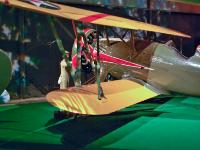 42 The U.S. Army Air Corps received its first P-12 in February 1929 and the last P-12F in May 1932. It was the last of the biplane fighters flown by the Army and a few remained in service until 1941. Boeing produced 366 P-12s for the Army, with more P-12Es built (110) than any other series. The P-12E on display served with the 6th Pursuit Squadron in Hawaii during the 1930s and the Army retired it in 1940. It was donated it to the museum in 1973 and museum specialists completed restoration in 1983. |
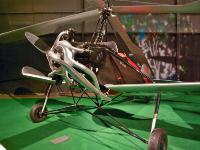 43 KELLET K-2/K-3 AUTOGIRO. Like helicopters, autogiros used a rotary wing to produce lift. However, unlike helicopters, the engine did not power the autogiro's rotor. Instead, aerodynamic forces made the autogiro rotor spin, while the engine propelled the aircraft. The most famous Kellett was the K-3 that Admiral Richard E. Byrd used on his Antarctic Expedition of 1933-1934. The aircraft on display was the first autogiro tested by the Army Air Corps at Wright Field in 1931. |
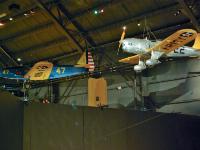 44 RYAN YPT-16 (foreground) became the first monoplane acquired by the U.S. Army Air Corps as a primary trainer. It had a metal fuselage and wooden wing spars with fabric covering and external wire bracing. FAIRCHILD PT-19A CORNELL (rear) Fairchild developed the PT-19 in 1938 to satisfy a military requirement for a rugged monoplane primary trainer and it went into quantity production in 1940. Altogether, the U.S. Army Air Forces accepted 7,742 Cornells, of which 4,889 were PT-19s. Howard Phillips of Seattle donated the PT-19A on display at the museum in November 1984. |
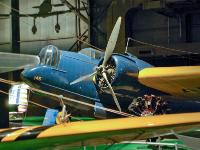 45 The MARTIN B-10 was the first "modern" all-metal monoplane bomber produced in quantity. It featured such innovations as retractable landing gear, a rotating gun turret and enclosed cockpits. Powered by two 775-hp Wright R-1820 Cyclone engines, Martin's advanced design made the B-10 50 percent faster than contemporary biplane bombers and as fast as most of the fighters. This capability convinced many U.S. Army Air Corps planners that bombers could successfully attack strategic targets without long-range fighter escort. |
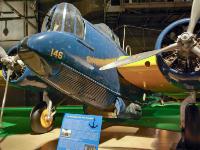 46 The aircraft on display, an export version sold to Argentina in 1938, is the only remaining B-10. In 1970 the Argentine government donated the airplane to the U.S. Air Force Museum. The 96th Maintenance Squadron stationed at Kelly Air Force Base, Texas, restored the aircraft from 1973-1976. |
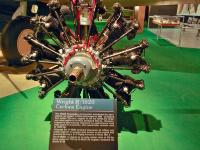 47 The Wright Aeronautical Corp. introduced the 9-cylinder, air-cooled WRIGHT R-1820 "CYCLONE" 575 HP radial engine in 1931. However, engineers dramatically improved its performance over many years of production, with several later versions being rated at 1,525 hp. The R-1820 remains best known as the engine that powered Boeing's B-17 Flying Fortress in World War II. The R-1820B on display is an early version rated at 575 hp. More powerful 775-hp R-1820-33s powered the Martin B-10. |
 48 Looking towards the exit of the Early Years Gallery. The plane with the red cowl is a NORTHROP A-17A while the "crashed" plane near the exit is a NORTH AMERICAN BT-14 (NA-64) trainer. |
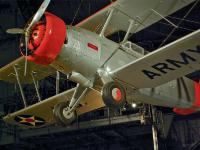 49 The DOUGLAS O-38F concluded a series of biplane observation aircraft begun in the early 1920s. Between 1931-1934, Douglas built 156 O-38s for the Air Corps, eight of which were O-38Fs. With a cruising speed of only 128 mph, it was obsolete by the end of the 1930s, but some O-38s remained in service at the time of Pearl Harbor in 1941. |
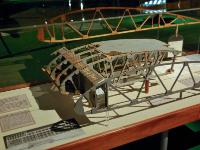 50 This is part of the original wing of a DOUGLAS O-38F that crashed in Alaska on June 16, 1941. The O-38F on display was the first airplane to land at Ladd Field near Fairbanks, Alaska which became famous during World War II as the place from where American-built aircraft flew to the Soviet Union under the Lend-Lease program. |
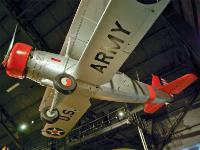 51 This aircraft crashed due to engine failure about 70 miles southeast of Fairbanks. Uninjured, the pilot and his mechanic hiked to safety after supplies were dropped to them. The abandoned aircraft remained in the Alaskan wilderness until the museum arranged for its recovery by helicopter in June 1968. Despite being exposed to the Alaskan weather for 27 years, the aircraft remained in remarkable condition. Only the wings required extensive restoration. |
 52 The BOEING P-26A was the U.S. Army Air Corps' first all-metal monoplane fighter in regular service. Affectionately nicknamed the "Peashooter" by its pilots, the P-26A could fly much faster in level flight than the Air Corps' older wood and fabric biplane fighters. The P-26A also had a higher landing speed and, although not initially fitted, P-26As were later fitted with wing flaps to reduce landing speeds. |
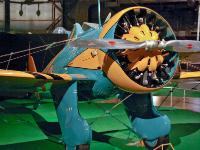 53 Even with its monoplane design and all-metal construction, the Peashooter retained some traditional features, such as an open cockpit, fixed landing gear and external wing bracing. The P-26A was the last Air Corps fighter to have these obsolete characteristics. This P-26A reproduction is painted to represent the commander's aircraft of the 19th Pursuit Squadron, 18th Pursuit Group, stationed at Wheeler Field, Hawaii, in 1938. |
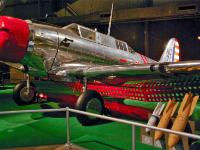 54 The NORTHROP A-17A was the last of the pre-World War II single-engine attack aircraft ordered into production by the Army Air Corps. Its fate was sealed in 1938 when the Army Air Corps determined that all future attack aircraft procured would be multi-engine models. In addition to bombs, the A-17A was armed with four forward-firing .30-cal. machine guns for strafing, and one flexible mounted .30-cal. gun in the rear cockpit for self-defense. |
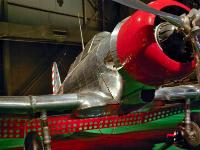 55 A-17As were in service for less than four years. In June 1940, all but 20 A-17As were sold overseas. The remaining Army Air Forces A-17 and A-17As were used as advanced trainers and squadron support aircraft with most ending up as ground maintenance trainers. The last A-17A was written off in early 1945. The aircraft on display is the only A-17 series aircraft known to exist. It was delivered to the Air Corps and assigned to Barksdale Field, La., on June 25, 1937. |
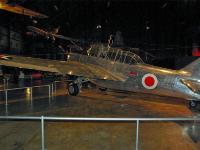 56 NORTH AMERICAN O-47B In 1934 North American Aviation developed the O-47 to replace the O-19 and O-38 observation biplanes. Larger and heavier than most preceding observation aircraft, its crew of three sat in tandem under the long canopy. Since the wings restricted downward observation and photography, North American put windows in the aircraft's deep belly. |
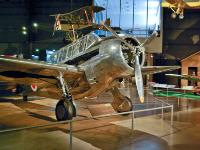 57 The U.S. Army Air Corps ordered 174 O-47s in 1937, and in 1938, ordered 74 O-47Bs, which had a redesigned engine cowling for better cooling, a more powerful engine, and improved radio equipment. The museum acquired the O-47B on display in 1978 and the Ohio Air National Guard, Mansfield, Ohio, restored the aircraft in the markings of an O-47A of the 112th Observation Squadron of the Ohio National Guard. |
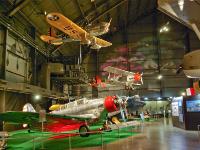 58 Looking back towards the A17A, the B-10 and the O-38F |
 59 This display is called "A flight training mishap" that demonstrates what could happen to a cadet pilot when taxiing with the wind from behind and applying his brakes too hard. The wind would lift the tail, and the nose would hit the ground. |
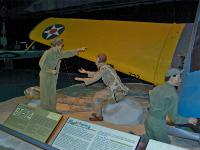 60 Such an accident resulted in at least a stern lecture from the instructor and possibly the student's dismissal from the school. On average during the war, 40 percent of the cadet pilots did not graduate from flying school. |
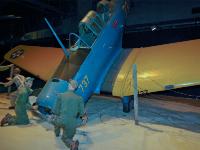 61 The NORTH AMERICAN BT-14 was a basic trainer developed by North American from its earlier BT-9. Except for the fabric-covered movable surfaces on the tail and wings, the BT-14 was an all metal aircraft. The Army Air Corps purchased 251 BT-14s. |
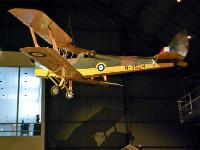 62 The DE HAVILLAND DH 82A TIGER MOTH made its first flight on Oct. 26, 1931. It is one of a number of models of light aircraft named for moths, in recognition of designer Geoffrey de Havilland's interest in moths and butterflies. It became popular with air forces throughout the United Kingdom as well as the civilian aviation market. In Britain, 8,101 were manufactured plus 2,751 more in Canada, Australia and New Zealand. |
 63 In 1940 the U.S. Army Air Corps ordered 203 CURTIS O-54 "Owls" for observation duties. Upon America's entry into World War II, the U.S. Army Air Forces realized that the airplane lacked the performance necessary for combat operations overseas and relegated it to stateside courier duties and short-range submarine patrols off the coasts of the United States. The O-52 was the last "O" type airplane procured in quantity for the Army. Was an uglier aeroplane ever built? |
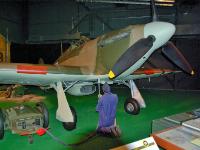 64 HAWKER HURRICANE MKIIA. The Hawker Hurricane was one of the most famous British fighters of World War II. The prototype was first flown in November 1935 and the first production aircraft made its initial flight in October 1937. Within a matter of weeks, Hurricanes were being delivered to their operational squadrons. By the time the war broke out in September 1939, the Royal Air Force had taken delivery of about 500 Hurricanes and production continued. END OF TOUR THROUGH THE EARLY YEARS GALLERY. Next folder: Air Power Gallery WWII |
